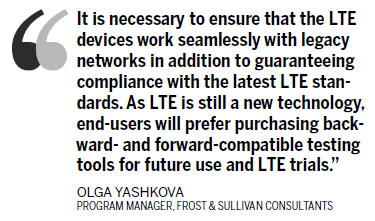
Opportunities arrive as 4G mobile standard is embraced
China's deployment of third-generation wireless networks and its embrace of the fourth-generation mobile standard have not only created business opportunities for the world's telecoms equipment vendors but also for the test equipment makers, analysts said.
Ever since Chinese telecom operators received 3G licenses in 2009, the huge demand for network infrastructure has helped Huawei Technologies Co and ZTE Corp to grow fast and compete in the world's top league, rivaling Telefon AB L.M. Ericsson and Alcatel-Lucent.
|
 Agilent Technologies' logo in front of the company's headquarters in Palo Alto, California. Agilent is the first industry player to provide test equipment and solutions that support China's 4G long-term evolution technology, said Andy Botka, Agilent vice-president and general manager of the microwave and communication division. [Photo/China Daily] |
According to Research and Markets, the global telecoms equipment market will increase at a compound annual growth rate of 3.6 percent over the period 2010 to 2014. Countries in Asia-Pacific regions, especially China, are likely to contribute the most sales, at one-third of the total.
As more people surf the Internet through mobile phones, the burgeoning mobile traffic has put pressure on the carriers' networks and prompted them to deploy the 4G long-term evolution (LTE) technology.
China Mobile Ltd, the world's biggest wireless carrier by user base, is conducting large-scale trials of a homegrown 4G technology in 13 cities. The company aims to have 200,000 TD-LTE base stations through new-builds or upgrades by 2013.
The LTE network construction "is expected to create numerous opportunities for wireless test equipment vendors", according to a report issued by research firm Frost & Sullivan.
The global LTE test equipment market generated revenues of $76.08 billion in 2011 and is estimated to reach $284.56 billion in 2018, driven by increasing wireless data and network deployments, the report said.
Multiple types of test equipment and technologies for applications such as research and development, manufacturing, installation and maintenance and monitoring will push the growth of the overall LTE test equipment market.
|
 |
Spun out of Hewlett-Packard in 1999, the US-based company entered into a cooperation with Datang Telecom Technology & Industry Group in 2011 to conduct research and development work for testing 4G products. Datang was the initiator of China's homegrown 4G TD-LTE technology.
Agilent is the first industry player to provide test equipment and solutions that supports China's TD-LTE technology, said Andy Botka, Agilent vice-president and general manager of the microwave and communication division. In addition to that, Agilent provides a full portfolio of test and measurement solutions for the LTE/LTE-Advanced technology, he added.
China is Agilent's second-largest market, after the United States, and "it won't be long" before it becomes the single largest market, said Mario Narduzzi, marketing manager of Agilent's China Communications Operation last year.
However, the increasing LTE deployments could also pose a key challenge for wireless test equipment vendors, said Olga Yashkova, program manager at Frost & Sullivan.
At present, global LTE deployments are backward-compatible with existing GSM and code division multiple access, Wi-Fi and WiMAX offerings.
"It is necessary to ensure that the LTE devices work seamlessly with legacy networks in addition to guaranteeing compliance with the latest LTE standards," he said.
"As LTE is still a new technology, end-users will prefer purchasing backward- and forward-compatible testing tools for future use and LTE trials."
shenjingting@chinadaily.com.cn


 Washington to remain focused on Asia-Pacific
Washington to remain focused on Asia-Pacific RQFII target blue chips amid bear market
RQFII target blue chips amid bear market Australian recall for top two exporters
Australian recall for top two exporters China fears new car restrictions
China fears new car restrictions